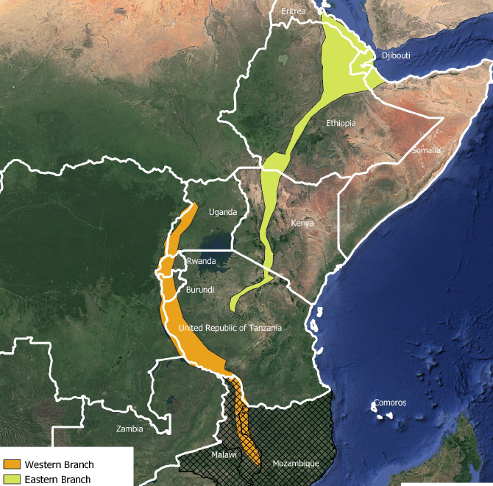Geothermal power is produced by drilling thousands of feet into ‘hotspots’ in the Earth’s crust, in a process similar to drilling for natural gas, in order to harness high (150°C+) temperature water for the production of electricity and heat.
The Great East African Rift System (EARS) is a major tectonic structure that extends 6,500 kilometers from the Middle East (Dead Sea – Jordan Valley) in the north to Mozambique in the south. This system provides significant geothermal potential to the region, by some estimates as much as 20GWe, which is about as much as exists across all technologies in the region today.
The EARS is composed of two rift trends: the eastern and western branches.

- The eastern branch exhibits the high temperatures necessary for power generation, and runs through Ethiopia, Eritrea, Djibouti, Kenya, Somalia and the north-west of Tanzania.
- The western branch is more suitable for direct-use applications and runs through Burundi, Uganda, Rwanda, the west of Tanzania, Malawi, Mozambique and the north of Zambia. Direct-use applications include greenhouse and aquaculture heating, drying agricultural products (such as cereal, fruits and vegetables), milk pasteurisation, meat and fish processing, cooling and refrigeration.
Power in EARS countries and the potential for geothermal
95% of power in East Africa comes from hydropower and fossil fuels. Years of drought have contributed to chronic power shortages and high electricity prices, which have:
- Cost an estimated 2 – 4 % of GDP annually, undermining economic growth, job creation, and investment.
- Driven emergency diesel use higher, causing local pollution problems and contributing to climate change.
Scaling up geothermal has potential economic, security and environmental benefits given that it:
- Is domestically produced, providing energy security and price stability.
- Can provide stable base load supply. Newer technology allows for load-following applications that enable variable renewable energy.
- Emits zero greenhouse gasses and negligible local pollution.
- Can help decarbonize industry through direct-use applications.
Geothermal can be a critical component to helping these countries meet their Paris Climate Commitments and build expanded, low-carbon energy systems.
Status of the sector in EARS countries
Today, the region has developed less than 5% of its total potential geothermal capacity, with almost all of it in just two countries.
- Kenya is East Africa’s leading geothermal producer with 828MW of power capacity across 3 projects, and is exploring at least 9 more. There will be even more growth here as foreign companies obtain exploration licenses. The state-owned Geothermal Development Company (GDC) currently handles exploration and development of geothermal fields, while private corporations and public-private companies such as KenGen receive generation concessions.
- Ethiopia is the only other country in the region that has developed its geothermal resource. It has just 7.3MW of installed capacity, however numerous projects (e.g. Aluto-Longano, Tendaho-Alalobeda, Corbetti, Tulu-Moye, Fantale, Wondo-Genett, Boku, Duguna Fango, etc) are in various phases of exploration. Both private and public developers are leading exploration across 10 fields.
The governments of Comoros, Djibouti, Uganda, and Tanzania, with assistance from international agencies and donors, are actively exploring another 12 sites for geothermal resources. Mozambique, Malawi, and Somalia are candidates to invest in exploration, but there are currently no plans to do so.
TABLE 1: East African geothermal potential and installed capacity
| Country | Geothermal potential (MW | Installed capacity (MWe) |
| Comoros | 40 | – |
| Ethiopia | 10,000 | 7.3 |
| Djibouti | 1,000 | – |
| Kenya | 10,000 | 828 |
| Uganda | 450 | – |
| Tanzania | 5,000 | – |
Despite geothermal’s great potential, East African countries generally haven’t exploited this resource due to the high upfront investment required, inherent risk with discovering and developing it, and unsupportive regulatory, financial, and institutional frameworks.
Read more about the Major Barriers to Scaling Up Geothermal in East Africa.

